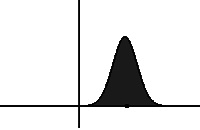Reference
PII: 0304-4149(82)90051-5 (core.ac.uk) @andersonReversetimeDiffusion1982 : 專門針對 reverse time SDE equations.
http://pordlabs.ucsd.edu/pcessi/theory2019/gardiner_ito_calculus.pdf
Ito equations
Introduction
時光倒流 (time reversal) 在日常生活幾乎不可能。所有的觀察 (非實驗結果) 歸納出熱力學第二定律:熵隨時間增加。因此複雜系統的演進過程,例如生米煮成熟飯,只能一個方向發展,時光倒流看起來不可能發生。但在微觀系統的方程式並沒有時光倒流的矛盾s問題,也就是 forward-time 和 backward-time 都是完全合理物理運動,而且對稱。只要把方程式的 $t \to -t$ 基本就可以描述 time reversal.
回到日常生活,對於 (非隨機過程) 簡單系統,例如撞球或是星球運行,時光倒流是合理可以發生。同樣也是把方程式的 $t \to -t$ 就可以描述。
但對於隨機過程簡單系統,這就非常有趣:到底是類似熱力學熵增加,無法時光倒流。還是比較類似微觀或簡單系統存在時光倒流,並可用簡單的 time symmetry, 也就是 $t \to -t$, 就可以描述?
答案是:Yes, 存在時光倒流。No, 不是簡單的 time symmetry ($t \to -t$).
其他問題:
- 簡單隨機系統有熵 (entropy) 增加的概念?或甚至 governed by entropy increase law?
- 因爲有 randomness, 所以還是有 entropy 概念?但不一定是熵增加。在 non-stationary transient process, 還是可以做時光倒流 (time reversal) 或是熵減小。
| Forward-time | Backward-time | |
|---|---|---|
| 複雜系統 | 熱力學熵增加 | No (熵無法變小) |
| 微觀系統 | 量子力學,場論 (no entropy) | Yes, $t \to -t$ |
| 簡單非隨機系統 | 古典力學 (no entropy) | Yes, $t \to -t$ |
| 簡單隨機系統 | 隨機微分方程 (SDE): Ito or Fokker-Planck equations | Yes, reverse SDE |

隨機過程簡單系統
一個問題是隨機過程簡單系統有什麽實際用途?
非常多,例如 noisy control system, robust control system, finance system
更進一步,隨機過程的時光倒流 (減熵) 有什麽用途?
信號處理的 smoothing 問題
最近大熱門的 diffusion process 就是利用時光倒流來 train 一個 neural network.
之後可以用 noise 產生 image. 更廣汎說,可以從一個機率分佈 transform 到另一個機率分佈。作爲生成式 AI 或是 style transfer AI.
有幾類隨機過程問題:
- Signal + noise estimate the original signal (Kalman filter, Kalman-Bucy filter)
- 布朗運動 : 描述現象 only?
- Distribution A + noise : diffusion denoise
此處我們討論隨機微分方程 (Ito equation) 的 forward-time 和 backward-time 的形式和對應 Fokker-Planck equations。
(Forward) Ito Differential Equation
我們從 general 的 stochastic differential equation (SDE) 開始: \(\begin{align} d x_t=f\left(x_t, t\right) d t+g\left(x_t, t\right) d w_t \end{align}\) where $w_t$ has the usual properties. (就是 Wiener process, white noise)
以上是 random samples or process 的微分方程。可以用來作爲 Monte Carlo 模擬,但無法直接計算機率分佈如何隨時間變化。所以可以導入機率分佈的偏微分方程 Fokker-Planck equation 如下。
Forward unconditioned equation (Fokker-Planck equation)
也就是 Fokker-Planck Equations, yields \(\begin{align} -\frac{\partial p\left(x_t, t\right)}{\partial t}= & \sum_i \frac{\partial}{\partial x_t^i}\left[p\left(x_t, t\right) f^i\left(x_t, t\right)\right] -\frac{1}{2} \sum_{i, j, k} \frac{\partial^2\left[g^{i k}\left(x_t, t\right) g^{j k}\left(x_t, t\right) p\left(x_t, t\right)\right]}{\partial x_t^i \partial x_t^j} . \end{align}\) 以上可以説是 general diffusion equation.
-
左邊是機率分佈對時間微分。
- 右邊第二項是機率分佈對空間的二次微分,就是機率分佈 Laplacian (空間 tension)。
- 右邊第一項是機率分佈的 transient 項?如果 eigenvalue 實部小於 0, 會隨時間 exponential 消失。
Backward (not reverse-time, not $t \to -t$) Kolmogorov equation
for $s \geqslant t$ is
\[\begin{align} -\frac{\partial p\left(x_s, s \mid x_t, t\right)}{\partial t}= & \sum_i f^i\left(x_t, t\right) \frac{\partial p\left(x_s, s \mid x_t, t\right)}{\partial x_t^i} +\frac{1}{2} \sum_{i, j, k} g^{i k}\left(x_t, t\right) g^{j k}\left(x_t, t\right) \frac{\partial^2 p\left(x_s, s \mid x_t, t\right)}{\partial x_t^i \partial x_t^j} \end{align}\](Backward) Ito Differential Equation
推導參考 reference and appendix. Backward Ito Differential Equation 如下:
\[\begin{align} \mathrm{d} \bar{x}_t=\bar{f}\left(\bar{x}_t, t\right) \mathrm{d} t+g\left(\bar{x}_t, t\right) \mathrm{d} \bar{w}_t \end{align}\]where $\bar{f}^i$ is: \(\begin{align} \bar{f}^i\left(x_t, t\right)=f^i\left(x_t, t\right)-\frac{1}{p\left(x_t, t\right)} \sum_{i, k} \frac{\partial}{\partial x_t^i}\left[p\left(x_t, t\right) g^{i k}\left(x_t, t\right) g^{i k}\left(x_t, t\right)\right] \end{align}\)
Ito Differential Equation Examples
綫性 Ornstein-Uhlenbeck Equation (Foward and Backward)
假設 $x$ 是 non-deterministic, wide-sense stationary $n$-dimentional process, 並由下述綫性微分方程表示:
\[\begin{align} \mathrm{d} x=A x \mathrm{~d} t+B \mathrm{~d} w . \\ \end{align}\]其中 $A, B$ 都是常數矩陣。$A$ 的 eigvalues 實部小於 0. $w$ 是 vector Wiener process.
這個 forward-time 的解形式 (representation) 如下: \(\begin{align} x(t)=\int_{-\infty}^t \mathrm{e}^{A(t-s)} B \mathrm{~d} w(s) . \end{align}\)
此處假設 $A$ 的 eigenvalues 實部小於 0 (隨時間增加收斂)。
我們可能會推測 reverse-time 的解形式 (representation) 如下。但這是 time-reverse ($t\to -t$) 的想法。就是 $x(t)$ 時間減小而變大。 \(\begin{align} x(t)=-\int_t^{\infty} \mathrm{e}^{\bar{A}(t-s)} \bar{B} \mathrm{~d} \bar{w}(s) . \\ \end{align}\)
我們這裏想得到的是一個 forward-time representation of “$x(t)$ a reverse-time representation”. 就是把 reverse-time 轉換 (unfold) 成 forward-time 的 solution. 此時新的 $x(t)$ 隨著時間增加而變大。所以我們要魔改原始的 Ito SDE。A reverse-time SDE is: \(\begin{align} \mathrm{d} x=\bar{A} x \mathrm{~d} t+\bar{B} \mathrm{~d} \bar{w} \\ \end{align}\)
此處 $\bar{A}$ 的 eigenvalues 實部大於 0.
\(\begin{align}
P=E\left[x(t) x^{\prime}(t)\right] .
\end{align}\)
The matrix $P$ is the solution of the linear matrix equation $P A^{\prime}+A P=-B B^{\prime}$, and is nonsingular precisely when rank $\left[B ,A B, \cdots A^{n-1} B\right]=n$.
Suppose $P$ is nonsingular, and define a vector process $\bar{w}$ by \(\begin{align} \mathrm{d} \bar{w}=\mathrm{d} w-B^{\prime} P^{-1} x \mathrm{~d} t, \quad \bar{w}(0)=0, \end{align}\) which in conjunction with 原始的 Ito equation implies \(\begin{align} \mathrm{d} x=\left(A+B B^{\prime} P^{-1}\right) \mathrm{d} t+B \mathrm{~d} \bar{w} = \bar{A} \mathrm{d}t + \bar{B} \mathrm{d}\bar{w} \end{align}\)
where
\[\begin{align} \bar{A} = A + B B' P^{-1}; \quad \bar{B} = B \end{align}\]可以證明 $\bar{A} = A + B B’ P^{-1}$ 的 eigenvalues 實部大於 0。 $\bar{w}(t)$ 是 vector Wiener process with $x(t)$ independent of past increments of $\bar{w}$, but not of future ones.
Equations (12) and (13) 基本是 equations (4) and (5).
Backward Fokker-Planck Solution
\[\begin{align} -\frac{\partial p\left(x_t, t\right)}{\partial t}= & A \sum_i \frac{\partial}{\partial x_t^i} p\left(x_t, t\right) -\frac{1}{2} B B' \sum_{i, j, k} \frac{\partial^2 p\left(x_t, t\right)}{\partial x_t^i \partial x_t^j} . \end{align}\]One has \(p\left(x_t\right)=\frac{1}{(2 \pi)^{n / 2}|P|^{1 / 2}} \exp \left\{-\frac{1}{2} x_t^{\prime} P^{-1} x_t\right\}\) 重點應該是 $P$ 應該隨著時間改變。
Here, $P$ is the solution of $P A^{\prime}+A P=-B B^{\prime}$, and is assumed nonsingular. Then \(\begin{aligned} \frac{1}{p\left(x_t\right)} \sum_j \frac{\partial}{\partial x_t^j}\left[p\left(x_t\right) B^{j k}\right] & =-\sum_j \left(P^{-1}\right)^{j i} x_t^i B^{j k} \\ & =-k \text { th entry of } B^{\prime} P^{-1} x . \end{aligned}\) Thus, following (3.10), \(\mathrm{d} \bar{w}_{\mathrm{t}}=\mathrm{d} w-B^{\prime} P^{-1} x \mathrm{~d} t\)
Appendix
Appendix A
Because \(p\left(x_t, t, x_s, s\right)=p\left(x_s, s \mid x_t, t\right) p\left(x_t, t\right)\) we can attempt to obtain a partial differential equation for $p\left(x_t, t, x_s, s\right)$, regarding $x_t, t$ as the independent variables and $x_s, s$ as parameters. We obtain, combining (5.2) through $(5.4)$ \(\begin{aligned} \frac{\partial p\left(x_t, t, x_s, s\right)}{\partial t}= & \text { terms involving } f, g, p\left(x_t, t\right) \text { and } p\left(x_s, s \mid x_t, t\right) \\ & \text { and their } x_t \text {-derivatives. } \end{aligned}\) tions is, for $s \geqslant t$ \(\begin{aligned} -\frac{\partial}{\partial t} p\left(x_t, t, x_s, s\right)= & \sum_i \frac{\partial}{\partial x_t^i}\left[\bar{f}^i\left(x_t, t\right) p\left(x_t, t, x_s, s\right)\right] \\ & +\frac{1}{2} \sum_{i, i, k} \frac{\partial^2\left[p\left(x_t t, x_s, s\right) g^{i k}\left(x_t, t\right) g^{j k}\left(x_t, t\right)\right]}{\partial x_t^i \partial x_t^i} \end{aligned}\) where $\bar{f}^i$ is as before, viz, \(\bar{f}^i\left(x_t, t\right)=f^i\left(x_t, t\right)-\frac{1}{p\left(x_t, t\right)} \sum_{i, k} \frac{\partial}{\partial x_t^i}\left[p\left(x_t, t\right) g^{i k}\left(x_t, t\right) g^{i k}\left(x_t, t\right)\right]\) The same partial differential equation (but with different boundary conditions of course) is satisfied by $p\left(x_t, t \mid x_s, s\right)$ [and in fact $p\left(x_t, t\right)$ - this is trivial to see. Just as (5.3) corresponds to the forward model $(5.1)$, so then (5.5) has to correspond to the reverse model
\[\mathrm{d} \bar{x}_t=\bar{f}\left(\bar{x}_t, t\right) \mathrm{d} t+g\left(\bar{x}_t, t\right) \mathrm{d} \bar{w}_t\]